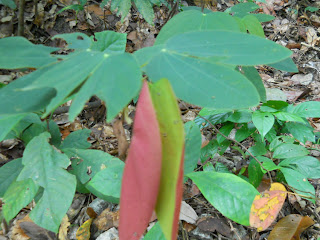Gnetum is a genus of about 30-35 species of gymnosperms, the sole genus in the family Gnetaceae and order Gnetales. They are tropical evergreen trees, shrubs and lianas. Unlike other gymnosperms they possess vessel elements in the xylem. Some species have been proposed to have been the first plants to be insect pollinated as they occur in association with the extinct pollinating scorpionflies
Many Gnetum species are edible, with the seeds being roasted, and the foliage used as a leaf vegetable. Some are also valued in herbal medicine.
This plant look like butterfly...
baby lianas
people cut these trees beacuse 2000+ visitor visit national park evey weekend,they need to make sure
some trees will not hurt the visitors...
me and jiaoyi were tried to test the gnetaceae..
the gnetaceae have bitter test....
i think it will be very testy after being roasted

















